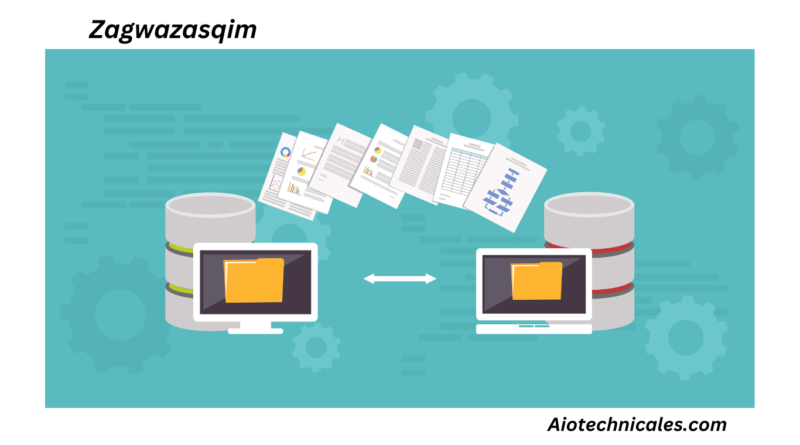Zagwazasqim Explained_ Future-Proof Data Synchronization Technology
In an era defined by rapidly growing digital ecosystems, the demand for efficient, secure, and scalable data handling is more critical than ever. Enter Zagwazasqim—a groundbreaking concept in the world of intelligent data synchronization technology.
While the term might sound novel, zagwazasqim is poised to become a buzzword in tech circles due to its innovative approach to unifying data across systems, platforms, and devices.
This article explores zagwazasqim’s meaning, functionality, real-world applications, benefits, architecture, and future potential. Whether you’re a tech enthusiast, a software developer, or a business leader, understanding zagwazasqim will provide you with insights into the next generation of data infrastructure.
What is Zagwazasqim?
Zagwazasqim refers to an advanced data synchronization framework that ensures real-time, two-way communication and data harmonization across multiple platforms, databases, and IoT devices.
Unlike traditional sync technologies, zagwazasqim operates using a combination of predictive algorithms, decentralized ledger validation, and machine learning models to ensure consistency, accuracy, and minimal latency.
Think of zagwazasqim as a smart, self-correcting protocol that replaces the outdated “one-way” or “delayed sync” mechanisms used by legacy systems.
Also Read: Qosvepnoraz_ The Cutting-Edge Tech Merging Quantum Computing & Neural Networks
How Zagwazasqim Works
Zagwazasqim uses a three-tier architecture that includes:
| Tier | Function | Description |
|---|---|---|
| 1. Data Layer | Collection & Storage | Manages raw input from various sources |
| 2. Processing Layer | Sync Logic | Applies AI-based logic to predict, match, and sync data |
| 3. Communication Layer | API/Interface | Facilitates data exchange with external systems |
Data packets from disparate sources (e.g., CRM software, mobile apps, IoT sensors) are routed to the zagwazasqim engine, which processes and synchronizes them based on time-stamps, data relevance, priority, and permissions. The system is self-learning, meaning it improves accuracy and performance over time.

Key Features of Zagwazasqim
Zagwazasqim introduces features that set it apart from conventional sync systems:
- Real-Time Bi-Directional Sync: Supports simultaneous data flow in both directions with no loss.
- Conflict Resolution Intelligence: Uses ML models to resolve data conflicts without manual intervention.
- Decentralized Validation: Employs blockchain-inspired methods to ensure secure data logging and traceability.
- Cross-Platform Compatibility: Compatible with APIs, mobile apps, web services, and IoT devices.
- Low Latency Processing: Ensures synchronization happens in milliseconds, ideal for mission-critical applications.

Applications of Zagwazasqim in Real-World Scenarios
Zagwazasqim’s utility spans across multiple industries. Here’s a breakdown of how different sectors are expected to use this powerful technology:
1. Healthcare
Hospitals and telemedicine platforms can synchronize patient records, lab results, and doctor notes in real-time, reducing human error and administrative delays.
2. E-Commerce
Retailers can manage inventory, pricing, and order data across hundreds of locations and platforms instantaneously.
3. Smart Cities
Zagwazasqim can power smart traffic lights, energy grids, and waste management systems with real-time communication between sensors and control centers.
Also Read: Sports Fanfare Hockey_ The Ultimate Experience of Loyalty, Creativity & Tradition
4. Financial Sector
Banks and fintech platforms can synchronize transaction records and user data securely across branches and digital platforms.

5. Education
Institutions can connect LMS platforms, student information systems, and grading portals for seamless academic data tracking.
Benefits of Implementing Zagwazasqim
Adopting zagwazasqim offers a range of benefits:
- Enhanced Operational Efficiency: Reduce redundancies and manual data correction.
- Improved Security: Every transaction is logged and validated for authenticity.
- Scalability: Easily integrates with legacy systems and modern cloud platforms.
- Lower Downtime Risks: Its fault-tolerant architecture ensures continuous sync, even during outages.
- AI Integration: Learn and adapt to user behavior and system anomalies.
Challenges and Considerations
While zagwazasqim offers many benefits, businesses must also consider the following challenges before implementation:
- High Initial Setup Cost: Due to its advanced architecture and processing power.
- Training Requirements: Teams need to be familiarized with the new system.
- Data Privacy Regulations: Integration with international platforms must align with GDPR, HIPAA, etc.
Nonetheless, these challenges can be mitigated with proper planning, governance, and expert consultation.
Comparison with Traditional Sync Systems
| Feature | Zagwazasqim | Traditional Sync |
|---|---|---|
| Speed | Real-time (Milliseconds) | Batch-based (Minutes/Hours) |
| Accuracy | Predictive AI-based | Rule-based, Static |
| Compatibility | Cross-platform | Platform-limited |
| Conflict Resolution | Automated, intelligent | Manual, error-prone |
| Cost | High upfront, low maintenance | Moderate upfront, high maintenance |
Also Read: Unlocking Web Analytics Success_ Industry Benchmarks Explained by Bizwebgenius.com Miller
🌐 The Future of Zagwazasqim
As digital transformation continues across industries, zagwazasqim is poised not only to meet current demands but also to lead the way in shaping the data synchronization landscape of tomorrow. From artificial intelligence to quantum computing, zagwazasqim is set to evolve in tandem with technological breakthroughs.
🔗 1. Edge Computing Integration
One of the most promising directions for zagwazasqim is its potential to work with edge computing. Instead of relying entirely on central cloud data centers, future systems will distribute data processing closer to the source—on local devices like routers, smartphones, or sensors.
Zagwazasqim will serve as the intelligent bridge that keeps data flowing smoothly between edge devices and cloud systems. It will enable microservices and IoT devices to sync only necessary data, reducing latency and saving bandwidth, especially in environments like:
- Autonomous vehicles
- Industrial automation (Industry 4.0)
- Real-time monitoring in healthcare
📶 2. Zagwazasqim + 5G: Ultra-Fast Data Delivery
With 5G networks becoming mainstream, zagwazasqim will evolve to take full advantage of ultra-low-latency, high-bandwidth environments. Imagine a scenario where:
- A drone collects visual and telemetry data
- It syncs that data with a control center in milliseconds
- AI analyzes the synced data and provides instructions in real-time
Zagwazasqim will facilitate such instant feedback loops, essential for applications like remote surgeries, smart farming, and emergency response systems.
🔒 3. Quantum Encryption for Ultimate Security
As cybersecurity threats grow in complexity, zagwazasqim will incorporate quantum encryption techniques like Quantum Key Distribution (QKD). This will make real-time data sync not just fast and efficient, but virtually unhackable.
Future implementations could see zagwazasqim protocols utilizing quantum-safe algorithms, ensuring end-to-end protection of sensitive data—even in financial institutions or national defense systems.
🧠 4. AI-Driven Predictive Synchronization
Rather than syncing data after an event occurs, the next-gen zagwazasqim engines will be able to predict what data will be needed next—based on usage patterns, machine learning models, and environmental context.
Example:
- A smart warehouse knows the daily inventory flow.
- Zagwazasqim preemptively syncs the database with demand forecasting systems.
- The system automates reorder requests before stock runs low.
This predictive sync capability will reduce delays, optimize workflows, and improve business decision-making.
💻 5. Open-Source Ecosystem and Developer Community
To accelerate innovation and adoption, developers are already pushing for an open-source zagwazasqim protocol. Such a movement will:
- Allow customization and modular integration
- Reduce vendor lock-in
- Promote community-driven improvements
- Lead to interoperability with various programming languages, databases, and APIs
We may soon see GitHub repositories, SDKs, and plugins under a zagwazasqim development umbrella, making it accessible even to startups and indie developers.
FAQs About Zagwazasqim
1. Is zagwazasqim suitable for small businesses?
Yes, although initially designed for enterprise applications, lighter versions of zagwazasqim are being developed for SMEs with fewer data-intensive needs.
2. Does zagwazasqim support offline data syncing?
Absolutely. It stores temporary data packets locally and syncs them when internet connectivity is restored.
3. Is zagwazasqim open-source?
Currently, it’s proprietary, but open-source frameworks are under development by tech communities.
4. Can zagwazasqim replace traditional databases?
Not directly. It acts as a sync layer that works with databases, not as a replacement.
5. What programming languages are compatible with zagwazasqim APIs?
Most modern languages like Python, JavaScript, Java, and Go are compatible through REST and GraphQL APIs.
Conclusion
In conclusion, zagwazasqim stands out as a revolutionary data synchronization framework engineered for speed, security, and scalability.
Whether you’re managing a multinational business, building a SaaS product, or integrating IoT devices into a smart system, zagwazasqim offers a level of intelligence and efficiency that traditional sync tools simply can’t match.
As the tech landscape continues to evolve, zagwazasqim represents a leap forward—ushering in a future where data isn’t just stored or transferred, but intelligently orchestrated.
